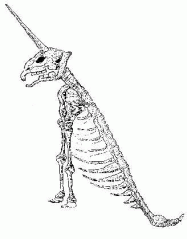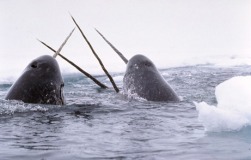SUGGESTED THEORIES
Theory #1: Misinterpretations
There are several animals that on their heads have a bony "horn" pertruding out of their forehead. The rhinoceros horn is such a protuberance, though it does not exceed a few inches in height, and is far from agreeing with the descriptions of the horn of the unicorn. The nearest approach to a horn in the middle of the forehead is exhibited in the bony protuberance on the forehead of the giraffe, but this also is short and blunt and is not the only horn of the animal, but a third horn, standing in front of the two others. Another potential Candidate that the Unicorn could be mistaken for is the Oryx of the Arabian Desert. When an Oryx stands sideways his horns are so perfectly aligned as to appear as one.
Disproved: This theory could not possibly be true though because for starters rhinos do not look anything at all like a horse or the fabled Unicorn, Unicorns as described do not have extremely long necks like giraffes do, and if the Oryx was misinterpreted for a Unicorn the person who saw what they thought was a Unicorn would probably eventually see the Oryx from the front unless of course they were looking at it from the side for several minutes which is highly unlikely seeing that the Oryx is almost always on the move.
Theory #2: They Never Existed
Many people think that Unicorns simply never even existed, but if bones were found that proved Unicorns may have actually existed they would believe in them.
Disproved: Well, it's your lucky day, non-unicorn believers! Recently, in a cave coincidentaly called Unicorn Cave in Ireland a scientist has found what he and many other scientists think to be real unicorn bones. (A sketch of these Unicorn bones has been provided below)
Theory #3: Explanation of the Narwhal Tooth
Another theory is that the unicorn was invented to explain the appearance of a narwhal tooth. The narwhal is a small whale of the most northern seas. The male grows a single long tusk that can be up to 10 feet long and it twists in a spiral. The horn is actually quite beautiful and it is easy to imagine that the people of the north would trade these to travelers for great amounts of goods and may have made up stories to enhance their worth to gullible tourists. Much the same happens today to tourists in exotic places. The Vikings of Norway were known to trade in narwhal horn and kept the secret of where they came from for over 300 years, from the Middle Ages through to the 17th century. During these time the horn of the "unicorn" became extremely valuable and sought after as is was thought to cure any disease or ailment as well as neutralizing all poisons and purifying water. In France the custom was to carry a horn, or a cup made with "unicorn" horn, around the table and to touch all the food and drink to test it for poison. This ceremony continued at the court of the King until as late as 1789. There are written accounts of great amounts of money spent on powdered horn, as well as for pieces said to be unicorn horn. So prized was the fabled horn of the unicorn that Queen Elizabeth I in the 16th century paid 10,000 pounds for one, equivalent to the cost of an entire castle. It is still in the royal treasury today. The royal scepter in England is made from the rare tusk. In Japan, two crossed narwhal teeth adorn the entrance to the Korninkaku Palace. In Denmark multiple teeth comprise the frame of the Danish throne.
Disproved: This theory cannot possibly be true since the "narwhal" horns supposedly actually did purify water as well as rid people of many diseases and recent tests in Europe have determined that narwhal horns do not actually purify water or rid people of diseases.



